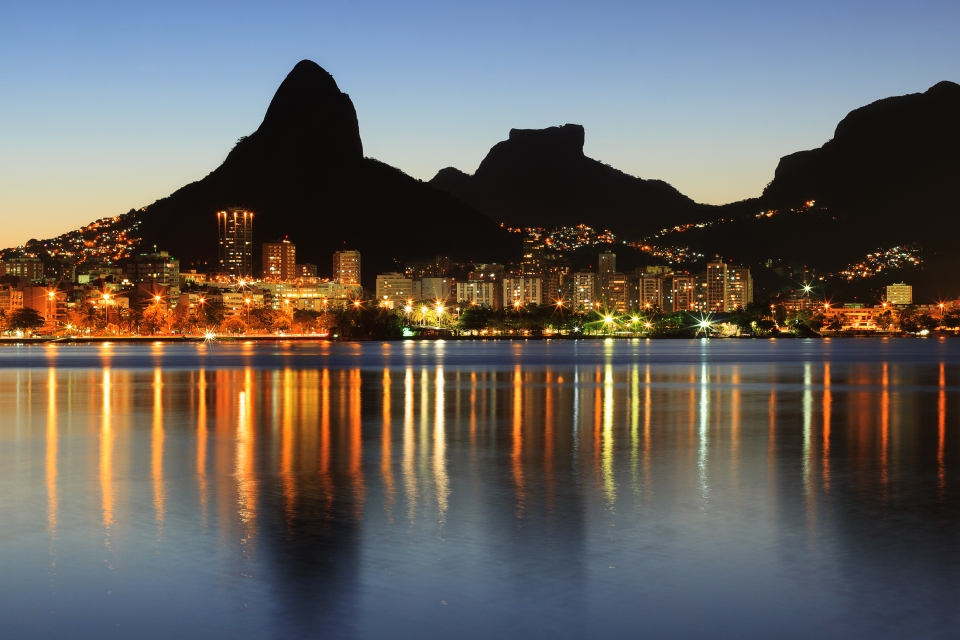Rodrigo de Freitas Lagoon
The city
The city of Rio de Janeiro, with its beautiful landscape and stunning geography, is well known for its beaches and forest-clad peaks, ridges and hills. Visitors can enjoy the kiosks on Copacabana beach, the charm and excitement of Ipanema, unforgettable sunsets at Arpoador and the tranquillity and natural beauty of the beaches to the west of the city, where lowland forests, restingas and mangroves are preserved in the Grumari and Prainha environmental protection areas. Although the city has become one of the largest urban areas in the world, it has grown around the Tijuca Forest, the largest urban forest in the world. For more tourist information we recommend the Visit.Rio website.
Origins
When the second Portuguese exploratory expedition, led by Gaspar de Lemos, arrived in January 1502 at the bay where the city of Rio de Janeiro is now located, the navigator thought it was the mouth of a river and decided to call the region Rio de Janeiro (January River). It was only in 1530, however, that the Portuguese court sent another expedition to colonize the area instead of simply continuing to use it as a stopover for their maritime expeditions. The French, in contrast, had been in Rio de Janeiro and the surrounding area since the beginning of the century and were willing to fight for the region. In 1560, after several battles, the Portuguese expelled the French. Read more.
Logistics and practical information
VISA
To find out if you need a visa to enter Brazil, please check Entrance visas for Brazil or consult your nearest Brazilian Consulate.
Vaccinations
The Brazilian Ministry of Health recommends vaccination against yellow fever, although this is not mandatory. Check with the authorities in your country. To be effective, yellow fever vaccination must be administered ten days prior to entering risk areas. The vaccination is valid for ten years.
Getting to and from the airport
Taxi: Here you can find the cost of a taxi ride to and from a destination of your choice.
Public transport: There are many executive buses (Frescão). These are more comfortable, and slightly more expensive, than regular buses and are air conditioned. Further information is available on the Vá de Ônibus website.
Transport in Rio de Janeiro
In the south of the city (where the conference venue and recommended hotels are), you can get around using the efficient subway network.
For more comfort, taxis are available at any time of the day. We also recommend you use transport apps. The services available with these apps are cheaper and also safe.
Currency
The official currency of Brazil is the real (R$). To exchange your currency for reals, you should go to an exchange bureau or an authorized bank. You can also find cash machines at the airport and around town. To check the currency value of the real against other currencies, please visit the Brazilian Central Bank website.
On May 18, 2018, € 1 was equivalent to R$4.41, and 1 US$ to R$3.75. One year ago, on May 18, 2017, the corresponding figures were R$3.76 and R$3.38. Be aware that this is an election year and the exchange rate may therefore be more volatile.
Foreign currencies (US$ or euro) are accepted only in some hotels or specific tourist locations.
Prices
Compared with other cities around the world, Rio de Janeiro is an average-price destination. Following are some estimated typical prices (based on the exchange rate of April 30, 2018):
Taxi ride (5 km): € 4.50
Taxi ride (10 km): € 7.00
Beer in a restaurant (0.5 litre): € 2.0
Big Mac meal: € 5.90
Meal in an average restaurant: € 7.50
Language
The official language of Brazil is Portuguese.
Weather
In September, daytime temperatures in Rio de Janeiro usually vary between 19 and 25 °C (66 - 77 °F).
Tipping
Tips (10 per cent) are included in taxi and restaurant bills and other services in Rio de Janeiro.
Emergency Number
Police or ambulance: 190



